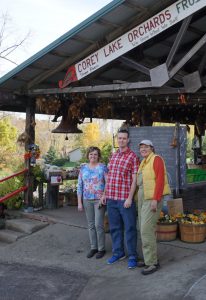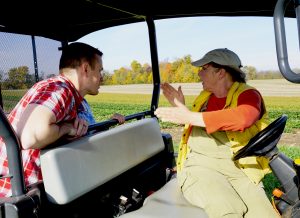
Beth Hubbard (right), owner of Corey Lake Orchards, worked with Sharon Hoch (left) and Grant Drallette (center) from Michigan’s St. Joseph County FSA office to insure crops on her farm through FSA’s Noninsured Crop Disaster Assistance Program.
by Savannah Halleaux, Public Affairs & Outreach Coordinator, Michigan FSA
At Corey Lake Orchards in Three Rivers, Michigan, (South of Kalamazoo) springtime means the strawberry beds are prepped, trees in the orchard are budding, grape pruning is done and tomatoes are thriving in the greenhouse. Manager Beth Hubbard waits for her asparagus crop to be harvest-ready, kicking off another season at the farm’s retail market.
In 2008, Hubbard left corporate America to manage her family’s farm and discovered the importance of the U.S. Department of Agriculture’s (USDA) safety net programs for diversified fruit and vegetable producers.
“You would think that with all this crop diversity we’d be financially covered,” explained Hubbard. “For example, if we had a bad year on strawberries, we’d have a good year on plums and it would be a wash. It doesn’t work that way. You can have a couple crop failures and the others still don’t tide you over.”
Hubbard said the USDA Farm Service Agency (FSA) Noninsured Crop Disaster Assistance Program (NAP) is important for Corey Lake Orchards because of the wide range of crops it produces.
“I think we use it almost every year. We have such diversity here that something is going to happen every year with at least one of the crops,” she said.
NAP provides financial assistance to producers of uninsurable crops when low yields, loss of inventory or prevented planting occurs due to natural disaster. Last year in Michigan, FSA provided over $4.2 million in NAP assistance to farmers and ranchers, many of them diversified fruit and vegetable operations like Corey Lake Orchards.

Beth Hubbard of Corey Lake Orchards, describes the effects of adverse weather on planting timeline, vegetable ripening times, pest management and its impacts on farm income to St. Joseph County FSA program technician Grant Drallette.
Corey Lake Orchards was enrolled in NAP when it was still operated by Hubbard’s parents. However, the program was new to Hubbard when she inherited the farm.
Hubbard found assistance from Grant Drallette, a FSA program technician at Hubbard’s local FSA Service Center in Saint Joseph County. Drallette worked with Hubbard to navigate the NAP dates and guidelines and clearly apply them to her operation.
“The attitude is always ‘we really want to help you,’” said Hubbard. “We developed a working relationship that allowed the farm to take advantage of all of the possibilities available through NAP.”
For more information on NAP, go to www.fsa.usda.gov/nap. For more information about USDA FSA in Michigan or to find your local office, visit www.fsa.usda.gov/mi.





